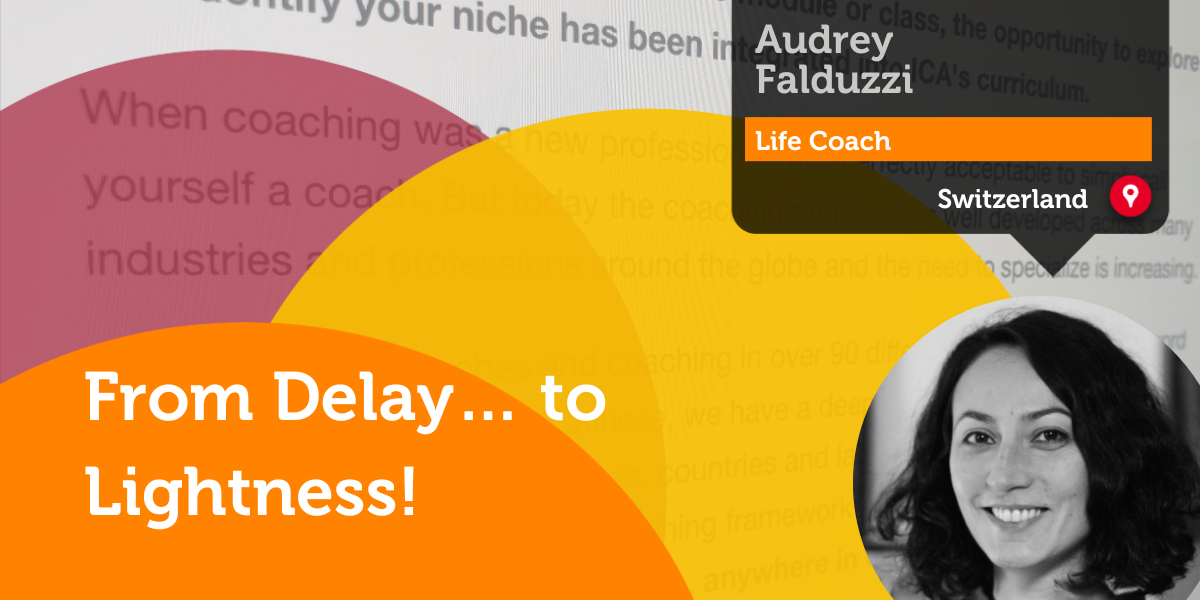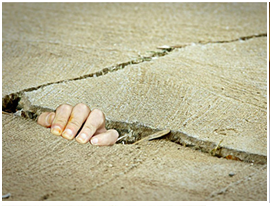A Case Study By Audrey Falduzzi, Life Coach, SWITZERLAND

Reframing a Perspective From Delay… to Lightness!
Natasa is an ICA student. We have been engaging in peer coaching sessions some months ago on a weekly/bi-weekly frequency. We have a trustful relationship based on respect and non-judgment.
We agreed before the session that we would use the Flip It tool. Thus, she was aware that the session would help her try to solve a recurrent issue that she was actively wanting to change and that she was prepared to change.
The Flip It tool worked incredibly well and truly helped Natasa to learn new things about herself. It took two sessions to come up with a powerful awareness-raising (session 1) that made clear to Natasa how she needed to change her perspective on the situation (session 2).
NB 1: The sentences in quotation marks (“…”) have been literally expressed by Natasaduring the session.
NB 2: The key moments of the session, when Natasa got awareness and deep insights are framed in pink.
Flip It Coaching Session: From Delay… to Lightness!
First Coaching Session (About 45 Minutes)
After a brief introductory talk, we started the session right away by using the Flip It tool. I asked Natasa, without mentioning the topic she wanted to address during the session, to think about the challenge she was having in her life and to select the image that represented her issue the most. I wanted her to stay emotionally connected to her situation and to associate it with an image intuitively, without having talked it through too much to avoid any intellectualization process.
Find It
After a first look, Natasa instinctively chose the 2 following pictures, that, she said, “reflect the active feeling” she is having about her situation:
 I asked her to look at them again and to see if one of them was reflecting her issue better than the other. She said that both pictures resonated, and she explained why by talking about her issue.
I asked her to look at them again and to see if one of them was reflecting her issue better than the other. She said that both pictures resonated, and she explained why by talking about her issue.
The Issue:
Natasa is not comfortable with what she calls “a pattern” that is activated whenever it comes to taking action. When she has to do something, she postpones it and leaves it for later until she cannot postpone anymore, especially when it comes to her studies at ICA. She feels furious and angry at herself. The trigger happened some days before when she realized that she was too late to register for a cycle of Observed Coaching labs and that she finally had to postpone it to the next month. She feels stuck because she “attempted in various ways and seemed not to get a breakthrough and allocate the time needed to do the work”.
 This image reminds her of a “rotten” energy she does not like. It reflects a feeling of lack of control and lack of “freshness”. The energy is not flowing.
This image reminds her of a “rotten” energy she does not like. It reflects a feeling of lack of control and lack of “freshness”. The energy is not flowing.
“Because I have time, it doesn’t matter, I don’t need to take action.”
On the other hand, she acknowledges that in her working days, she has been considered one of the most effective and action-oriented persons by her manager because she always delivers on time and in full.
 This image reminds her of how she feels when she is doing something close to the deadline.
This image reminds her of how she feels when she is doing something close to the deadline.
“Whenever I was delivering a task, I felt I was always stuck under the street, trying to find my way out. And what pushed me to go out are the deadlines.”
I asked Natasa what else she is feeling when she is close to a deadline. She answers that she feels motivated “for some reason”. Having deadlines is a motivator for her. Going back to the picture, she says that she feels like at some point her whole body is coming out from the road with an energy of activation, and motivation to deliver the result.
I draw Natasa’s attention to the fact that she associates this “last minute” action with motivation and being good and effective and ask her how it feels. She says she realized now that when she is close to a deadline, she feels excited, she is challenging herself to do the impossible.
The Challenge:
Although she recognizes that there is something energizing and motivating in acting last minute, she is not feeling good because she thinks she could have done more things if she had taken action earlier. She has the feeling she is wasting her energy, as if she is hibernating, while she is waiting.
She seems to be angry at herself when she realizes that “she did it again”. She would like to find a way to take action earlier.
Feel It
At this point in the session, in order to connect Natasa deeper to what she feels about her issue, we go to the feelings card. I asked her what feelings were associated with her challenge. Very quickly Natasa pinpoints feeling powerless, sad, ashamed, overwhelmed, and excited.
I ask Natasa if one of these feelings is stronger than the others. She says she mainly feels “overwhelmed”. She immediately associates that feeling with her need for perfectionism: what she delivers needs to be as perfect as possible(although she knows “perfect does not exist”), but as soon as she realizes that she does not have time to do something perfectly, she just acts.
At this moment Natasa seems surprised to realize that what overwhelms her the most is the need to deliver something perfect. At the same time, she also realizes that acting at the last minute kind of frees her from having to deliver something perfect because she does not have time to think about the perfect way of doing things.
We go now to the values card in order to understand what values are related to this feeling of being overwhelmed by her need for perfectionism. The values that are popping up are creativity and beauty. She explains that these values are her “signature values”.
Here is how Natasa associates the values of beauty and creativity with the feeling of being overwhelmed by her need for perfectionism:
- Perfectionism is related to creating beautiful results.
- Creativity reminds her of arts, but also of creating a template and creating a last-minute solution to address a problem.
At this moment Natasa realizes that she is more creative when she has less time to deliver because she is not looking for the perfect solution.
She also realizes that relating perfectionism to beauty brings a positive feeling. Then, perfectionism is not only associated with an unpleasant feeling but also with something she values.
Natasa was really surprised by this realization and could not figure it out. She needed more time to reflect on it. We were approaching the end of the session and we decided to take more time over a second session to talk this through.
Nevertheless, Natasa was curious to explore in the last 5/10 minutes we had from what perspective she thought she was looking at her problem.
Frame It
With little conviction, she decided to go for“Delay”: To postpone or defer an action (consciously or unconsciously).
Flip It
The empowering perspective resonating with the disempowering perspective of delay is “Action”: Commitment to the steps required for the achievement of your goals.
But, as she mentioned earlier, an action strongly resonates with creativity. In order to find quick solutions, she needs to tap into her creativity in order to bypass this need for perfectionism, to produce beautiful results.
She finally realized that in order to feed her need “to serve the value of beauty and to get to beautiful results, she needs to jump into her creativity value”. It allows her to feel emotions as well. She realizes that perfectionism is not the best part of her value of beauty and that it is keeping her back.
However, Delay vs Action was not resonating fully with her issue. That is how we ended our first “Flip It” session. She needed more time to process the strong insights and learnings she got from this 1st session.
Second Coaching Session (About 30 Minutes)
At the beginning of this session, Natasa said the 1st session had been eye-opening for her. Especially because she had been surprised when her need for perfectionism popped up somewhere between her values of creativity and beauty.
After the 1st session, she realized that “perfectionism is in the way”. Out of curiosity, she went back to the Feelings and Values cards.
Feel It
She connected herself to her situation and she looked back at the FEELINGS CARD. Most of the feelings she mentioned during the first session came back. Especially: Powerless, overwhelmed, and excited.
However, a new feeling popped up: disappointment. She felt disappointed with herself “for not having found the path to get to where I intend to and not doing it with an organized and step-by-step approach”.
In other words, she was not fully satisfied with the Flip It outcome of the 1st session.
When she looked back at the VALUES CARD, beauty, and creativity came back.
She said she realizes now how much she needs to trust her creativity. “Creativity is liberating”. She does not need to look for a perfect way but for a creative approach. “So when there is no more time, creativity plays a protagonist role”.
A new value popped up as well: growth. Growth is part of the process; it is a continuum that allows her to step out of perfectionism.
“Growth is the need to grow every day. I need to make the process to get to the result of ICA certification through an ongoing process / a day-to-day approach. Not a last minute.”
Frame It
In light of her new insights, we looked at the Flip It cards again to understand through which perspective Natasa was really considering her situation.
SIGNIFICANCE: Feeling overwhelmed and heavy; being overly attached to a particular outcome or belief.
She said: “Whatever I do has to be up to certain standards of excellence which in reality is limiting”.
Flip It
The empowering perspective resonating with the disempowering perspective of delay is LIGHTNESS: Being in the moment comes from a perspective of possibility and creativity.
Natasa immediately associated Lightness with the new perspective she wants and needs to adopt when it comes to her situation.
She said she needed to “enjoy the process”. She understands that ICA tasks and deliverables are “part of her growth and have to take place gradually in order to solidify the learning and the process”. Since it is a process, she“can always correct and improve it. It does not need to be perfect from the beginning”.
“I think this a major understanding as the profession of a coach requires a continuum, it is per se a growth process and there is no destination to be reached.”
Powerful Insights From Delay… to Lightness!
The Power tools brought Natasa into a journey where she unearthed powerful insights she did not think were lying under the surface.
Here are the main learnings Natasa found about herself through these sessions:
- “Not always seeking for the perfect but trying out things differently. To get in the process out of curiosity and the intention to learn.”
- “Trust my creativity and the way it makes me feel, liberated and full of energy.”
- “Embracing the hibernating phase as part of the action. It’s a preparation period.”
- “Trust that I have everything I need to act and trust that if it is not perfect, I can always improve it.”